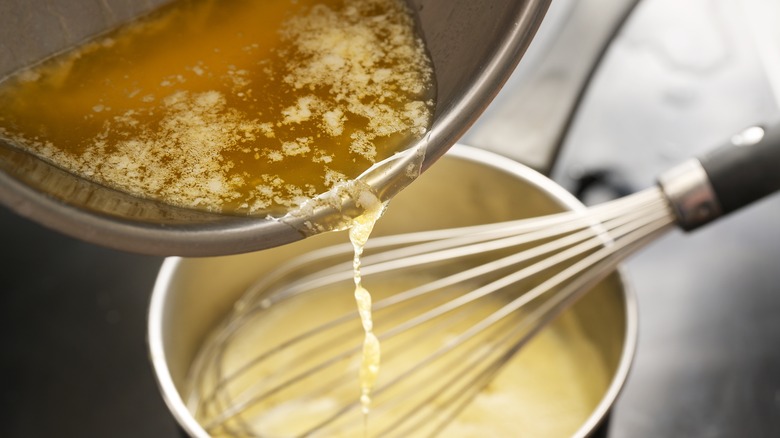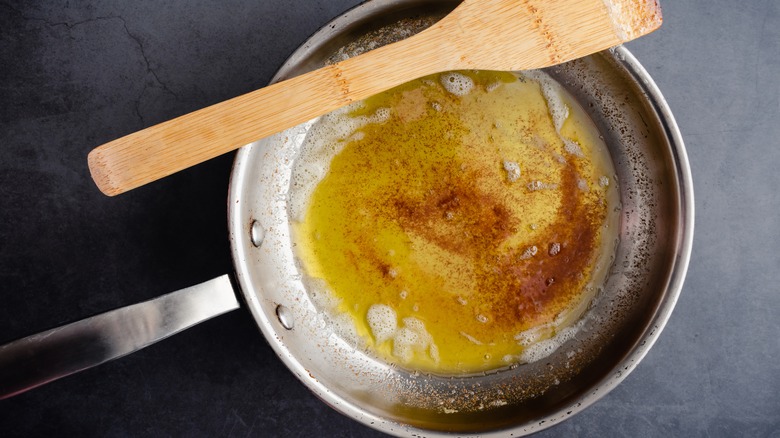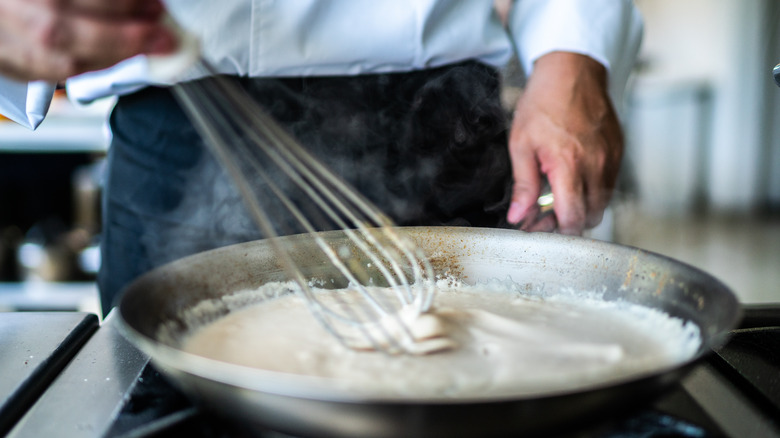Low Heat Is Your Best Friend When Making Butter Sauce
While the fable of the tortoise and the hare might seem like an unlikely lesson to apply in the kitchen, low heat and slow cooking make for a winning butter sauce. Racing to beat the clock to put food on the plate might be a short-order cook's requirement, but this luscious sauce needs time to create that impeccable flavor.
Transforming that stick or pad of butter into a liquid for a sauce requires constant attention because butter has a low melting point and a low smoking point. Those characteristics are why a stick of butter can turn into a pooling mess on a hot day or a golden liquid turns burnt brown quickly.
By using low heat when making a butter sauce, it melts slowly. As a spoon gradually stirs the solid pad into a bubbly, liquid, the process is controlled. Before the butter turns into a brown or blackened disaster, the pan can be removed from the heat source to reduce the temperature. While the moment between nutty, unctuous flavor and ruined, acidic mess is fleeting, a careful eye and cautious heating can be the difference between hitting the finish line and having to return to the solid butter starting point.
Choose indirect heat when working with butter
While low heat and slow cooking can keep butter from quickly burning, indirect heat can help to control melting too. Indirect heat avoids cooking immediately on top of a flame or burner. Whether you use a double boiler or place the pan near the heat source, this cooking method allows more control in the process. The proximity to the burner brings the elevated temperature, but the cooking is more gradual.
As an alternative, the pan can be placed on the heat source and then removed. The on-and-off heat concept not only keeps the heat level low but also helps to slow down the melting process. Both items are vital to keep the butter in the sauce from scorching or separating.
When butter is heated too quickly or at too high of a heat, it can separate. Since butter is a fat, the melted state is where the structure breaks down from a solid to a liquid. When the process is slow, the liquid has a consistency in viscosity and appearance. If it is rushed, the fats separate, which makes for an unpleasant appearance and taste. The visual difference between globby, pockets of fat settled in between a uniform sauce is unmistakable. Unlike a broken cookie that still tastes good, a broken sauce is not the sublime sauce of cooking perfection.
How to fix a broken butter sauce
From the rich hollandaise covering the perfectly poached egg to a delicate beurre blanc pairing over a halibut, a luscious butter sauce can elevate a multitude of dishes. While that velvety, smooth drizzle finishes the presentation, a broken puddle on the plate is unsightly. Low heat helps to keep that butter sauce from separating.
A key to any delicious butter sauce is emulsification, which is where two usually unmixable liquids combine. In a butter sauce, it is usually the fat, butter, and a liquid. When heated together at a low, slow temperature the ingredients become one. If the sauce boils, the ingredients will separate causing fat pockets, which is a sign of a broken sauce.
Although it is better to avoid the mistake than trying to fix it, a few tips can help bring those ingredients back together. Vigorous whisking can help make the two unmixable ingredients into one. Another option is to lower the temperature. For example, adding an ice cube on low heat can help. The combination of a little water and reduced heat can help the ingredient suspension.
While a luscious butter sauce might be the chef's kiss to perfect a dish, that finishing touch cannot be hurried. The low, slow rise in heat to create the final drizzle ensures that each bite is delectable.


